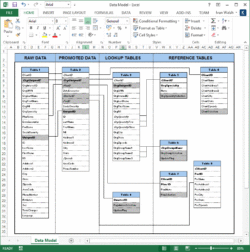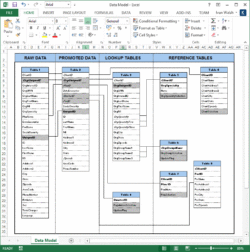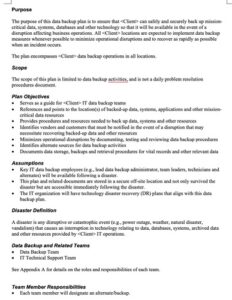Ever feel like you’re wandering in the dark when trying to understand the intricate workings of your database? You’re not alone! Databases are complex beasts, and without proper documentation, navigating them can feel like deciphering an ancient language. Imagine trying to build a house without blueprints, or assembling furniture without instructions. Chaos, right? That’s what happens when your database lacks clear, comprehensive technical documentation.
That’s where a solid database technical documentation template comes into play. Think of it as your database’s user manual, a living document that provides a roadmap for developers, administrators, and anyone else who needs to understand how your database is structured, how it functions, and how to maintain it. It’s not just about writing things down; it’s about creating a resource that empowers your team to work more efficiently, troubleshoot problems faster, and avoid costly mistakes.
In this article, we’ll explore the importance of database technical documentation, what a good template should include, and how to create documentation that’s actually useful. We’ll delve into the key elements, providing practical tips and insights to help you develop documentation that transforms your database from a black box into a well-understood and easily managed asset. Let’s dive in and shed some light on the world of database documentation!
Why is Database Technical Documentation So Important?
Database technical documentation is more than just a nice-to-have; it’s a critical component of any well-managed database system. It serves as a central repository of information, providing a clear and consistent understanding of the database’s design, functionality, and maintenance procedures. Without it, teams face a number of challenges, from difficulty onboarding new members to increased risks of errors and data loss.
Think about a scenario where a key database administrator leaves the company. Without proper documentation, their knowledge goes with them, leaving the remaining team scrambling to understand the intricacies of the system. This can lead to delays in resolving issues, difficulties in implementing new features, and a general sense of uncertainty about the database’s overall health. A well-maintained database technical documentation template mitigates this risk by capturing and preserving essential knowledge.
Furthermore, good documentation facilitates collaboration among team members. When everyone has access to the same information, it’s easier to communicate effectively, share ideas, and troubleshoot problems collectively. This is especially important in larger organizations with multiple teams working on different aspects of the database. Consistent documentation ensures that everyone is on the same page, reducing the likelihood of misunderstandings and conflicts.
Beyond day-to-day operations, database technical documentation plays a crucial role in disaster recovery planning. In the event of a system failure or data loss, accurate and up-to-date documentation can be invaluable in restoring the database to its previous state. It provides a clear roadmap for rebuilding the system, identifying critical dependencies, and recovering data from backups. Without this information, the recovery process can be significantly delayed and more prone to errors.
Finally, consider the long-term maintainability of your database. As your system evolves over time, changes will inevitably be made to its structure, functionality, and configurations. Without proper documentation, it can become increasingly difficult to understand the impact of these changes and to ensure that they are implemented correctly. Over time, the database can become a tangled mess of undocumented code and configurations, making it extremely difficult to maintain and upgrade. Investing in quality database technical documentation template is an investment in the future of your database.
Essential Elements of a Database Technical Documentation Template
A comprehensive database technical documentation template should cover a wide range of topics, providing a complete picture of the database system. While the specific content will vary depending on the complexity and purpose of the database, there are certain elements that should be included in every template. These elements ensure that the documentation is clear, concise, and useful to a wide range of users.
First and foremost, the documentation should include a high-level overview of the database’s purpose and architecture. This section should describe the overall goals of the database, the types of data it stores, and the relationships between different tables and schemas. It should also provide a diagram or visual representation of the database architecture, making it easier for readers to understand the overall structure of the system.
Next, the documentation should include detailed information about each table in the database. This should include the table’s name, a description of its purpose, a list of its columns, and the data types of each column. It should also specify any primary keys, foreign keys, or other constraints that apply to the table. For each column, it’s helpful to provide a description of the data it contains and any relevant validation rules.
In addition to table definitions, the documentation should also cover any stored procedures, functions, views, and triggers that are used in the database. For each of these objects, the documentation should provide a description of its purpose, its input parameters, its output values, and any relevant code snippets. It’s also helpful to include examples of how to use these objects in queries and applications.
Furthermore, the documentation should address security considerations. This should include information about user roles and permissions, authentication mechanisms, and data encryption methods. It should also describe any security policies or procedures that are in place to protect the database from unauthorized access or modification.
Finally, the documentation should include information about database maintenance procedures. This should include instructions on how to back up and restore the database, how to monitor its performance, and how to troubleshoot common problems. It should also specify any regular maintenance tasks that need to be performed, such as updating statistics or rebuilding indexes. A well-documented database is a well-maintained database, and a solid database technical documentation template makes that process much easier.
Documenting your database is a process, a journey of continuous improvement. It may seem daunting at first, but the benefits of clear, comprehensive documentation are undeniable. Embrace the process, start small, and gradually build up your documentation over time.
By investing in a good database technical documentation template and committing to keeping it up-to-date, you can ensure that your database remains a valuable asset for years to come, empowering your team to work more efficiently, make better decisions, and avoid costly mistakes.



